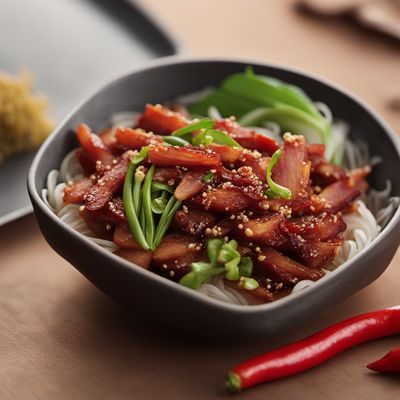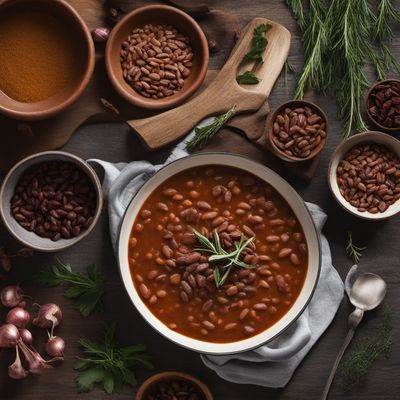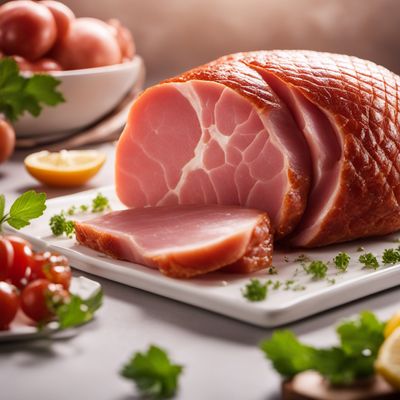
Ingredient
Bacon
"Sizzling Delight: Unveiling the Irresistible World of Bacon"
Bacon is a versatile ingredient made from cured pork belly that is typically sliced into thin strips. It is known for its distinctive taste, which combines saltiness, smokiness, and a hint of sweetness. The texture of cooked bacon can range from crispy to chewy, depending on personal preference. Its appearance is characterized by its reddish-brown color and marbled fat, which renders it succulent and flavorful when cooked.
Origins and history
Bacon has a long and storied history, with its origins dating back to ancient times. The practice of curing pork belly to preserve it can be traced to ancient China and Rome. In the Middle Ages, bacon became a staple in European diets, particularly in England. It gained popularity in the United States during the early 20th century and has since become an iconic ingredient in American cuisine.
Nutritional information
Bacon is a good source of protein and provides essential nutrients such as vitamins B3, B6, and B12, as well as minerals like zinc and selenium. However, it is also high in saturated fat and sodium, so moderation is key.
Allergens
Bacon is derived from pork, making it unsuitable for individuals with pork allergies.
How to select
When selecting bacon, look for slices that are evenly marbled with fat and have a fresh, pink color. Avoid bacon with excessive amounts of fat or a strong, unpleasant odor.
Storage recommendations
To maintain the freshness and quality of bacon, it should be stored in the refrigerator at temperatures below 40°F (4°C). It is best to keep bacon in its original packaging or transfer it to an airtight container or resealable bag to prevent exposure to air and odors.
How to produce
Producing bacon at home requires curing pork belly with a mixture of salt, sugar, and spices, then smoking or air-drying it. However, this process can be complex and time-consuming, so it is often more convenient to purchase bacon from a store.
Preparation tips
Bacon can be cooked in various ways, including frying, baking, grilling, or microwaving. To achieve crispy bacon, cook it over medium heat until it reaches your desired level of crispiness. For a chewier texture, cook it over lower heat. To reduce the fat content, you can blot the cooked bacon with a paper towel to remove excess grease.
Substitutions
Pancetta, Canadian bacon, or turkey bacon can be used as substitutes for bacon in recipes that require a similar flavor and texture.
Culinary uses
Bacon is a versatile ingredient that adds depth and richness to a wide range of dishes. It is commonly used in breakfast dishes like bacon and eggs, as well as in sandwiches, salads, soups, and pasta dishes. It can also be wrapped around other ingredients, such as vegetables or seafood, to infuse them with its smoky flavor.
Availability
Bacon is widely available in grocery stores and supermarkets worldwide.
More ingredients from this category
Recipes using Bacon » Browse all

Požeški Pijanci - Croatian Savory Pancakes
Savory Delights: Požeški Pijanci - A Croatian Pancake Extravaganza

Bosnian Coq au Vin
Sarajevo Chicken Delight

Hearty Austrian Potato Soup
Savory Alpine Delight: Hearty Austrian Potato Soup

Singaporean Chinese Style Fiery Love
Fiery Love: A Singaporean Chinese Twist on a Classic Icelandic Dish

Maple Bacon Koeksister
Sweet and Savory Maple Bacon Koeksister Delight

Welsh-Style Frijoles Charros
Hearty Welsh Cowboy Beans

Swedish Black Soup
Midnight Delight: A Savory Swedish Black Soup

Soulful Nasi Goreng
Soulful Nasi Goreng: A Flavorful Fusion of Indonesian and Soul Food Delights

Danish Bacon and Egg Cake
Savory Delight: Danish Bacon and Egg Cake

Eggs Benedict
Quick and Easy Eggs Benedict

Sichuan-style Spicy Pasta Carbonara
Fiery Fusion: Sichuan-inspired Pasta Carbonara

Caramelized Onion with Bacon
Savory Onion Delight: Caramelized Onion with Bacon Odia Style
